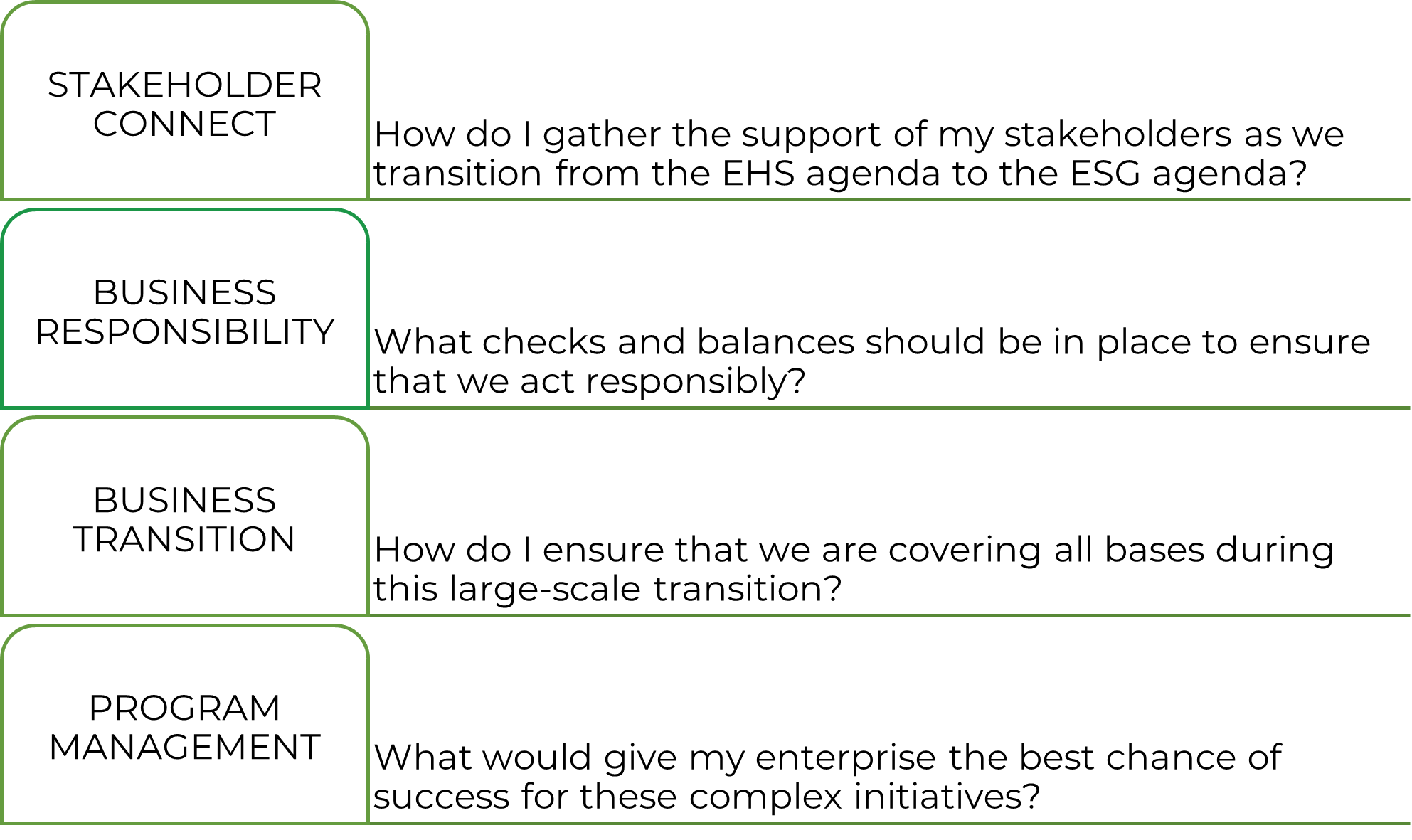
The significance of the EHS function cannot be emphasised enough, especially in the manufacturing industry. This has been an important role for many years in the corporate hierarchy to safeguard employee interest. The role primarily focuses on employee well-being, i.e health and safety. It is this proximity to social aspects that makes the EHS expert an obvious candidate for the emerging ESG roles within enterprises. While there is a dearth of skilled ESG professionals today, many companies have considered developing the required skills organically by upskilling their EHS experts.
At the outset, this looks like a step in the right direction. A couple of key aspects need to be given due consideration:
- Environment, Health and Safety (EHS) has a significant focus on employees and their well-being, while Environment, Social and Governance (ESG) requires the people boundary to extend to both internal stakeholders (including employees) and external stakeholders (Investors, Suppliers, Partners, Civil Society, Consumers, Regulators, Dealers etc)
- EHS and ESG have significantly varying scopes and purviews.
- E in EHS talks significantly of managing air quality, particulate matter, waste etc. While this eventually would result in reduced carbon footprint, the focus is not on tracking the footprint across the value chain. To the contrary E in ESG talks about addressing the GHG footprint across the value chain.
- The H and S of EHS focuses on occupational well-being of the workforce. This, of course, is a subset of the coverage of S in ESG. The reference to Social in ESG includes the well-being of all internal and external stakeholders
- Finally, there is limited reference to governance aspects in EHS and hence the G in ESG is a new dimension to explore for the EHS expert.
Considering these aspects, the EHS leaders are faced with a few pressing questions as they upskill themselves for the ESG roles within their respective organizations.

1. How do I gather the support of my stakeholders as we transition from the EHS agenda to the ESG agenda?
In today’s business environment, profitability and health are tracked using a wide array of social and environmental indicators, alongside the financial parameters. There is a growing emphasis on gathering the pulse of internal and external stakeholders relevant to your organization. It is significant to consider their touchpoints across the entire value chain of business operations and engage with them appropriately. This is the only way you can generate avenues for stronger alignment with the diverse stakeholder groups.
While your primary role requires you to stay focused on operational aspects of ongoing activities, you are also distinctly positioned with exclusive access to a diverse set of stakeholders across the value chain. As expectations from you to own the organization’s sustainability agenda grows, we suggest that you leverage this stakeholder access to your advantage. Alongside the conventional communications, you should explore engaging with the stakeholders using novel approaches like Design Thinking sessions. These can help them empathise and connect with your need/challenge/scenario better, and further generate ideas to address your broader sustainability agenda. Establishing stakeholder connect should involve a healthy mix of techniques that are educative, explorative, participative and communicative to ensure that any shift in the enterprise culture is received well.
2. What checks and balances should be in place to ensure that we act responsibly?
Acting responsibly has never been as significant as it is today. With growing scrutiny of enterprise actions from regulators, consumers, employees, investors etc, it has become imperative to address this strategically and operationally. It no longer suffices to say that a stakeholder-friendly enterprise action has been taken. It is important to call out the outputs, outcomes and impacts of such actions, while explicitly calling out the monitoring and evaluation frameworks used to track them. Challenges crop up when there is an insufficient assessment of impacts, poor program structuring, inefficient procedures or a combination of these factors. Poor knowledge of climate science and lack of alignment with global frameworks can work to compound the issue.
We propose that every initiative taken to address ESG, is assessed comprehensively for its systemic impacts, both in the near-term and long term. We suggest chalking out detailed Monitoring & Evaluation guides to ensure meaningful impact on the stakeholders and the planet. Finally, the teams executing the initiatives should be equipped with the right processes, methods and solutions to put the guidelines to action.
3. How do I ensure that we are covering all bases during this large-scale transition?
As businesses are taking the inevitable transition to the low carbon economy, it is bound to bring in changes across various business functions. From roles being redefined to offerings being rewired, from corporate communications shifting tracks to supplier relationships taking a new meaning – these changes will need every leader in the organization to assess and align with the transition. This clearly isn’t a momentary shift but a gradual progression, involving scenarios where you will need to course-correct along the way. One needs to be well-prepared for the long run.
We propose that you adopt a Systems Thinking approach to analyse every potential change or rewiring exercise in this transitional journey. This will help cut down the risks associated with the unpredictability of the transition. Due consideration must be given to the multi-stakeholder, multi-dimensional and multi-year aspects of business transition and accordingly plans must be drawn. Enterprises should adopt the Just Transition approach to ensure that both your internal and external stakeholders are not adversely impacted with the shift. Establishing these safeguards upfront gives your business the best chance of a successful transition to benefit from the low carbon economy.
4. What would give my enterprise the best chance of success for these complex initiatives?
Enterprises today operate in a multi-stakeholder environment to manage their end-to-end operations. From employees across the hierarchy to partners across the value chain, it is important to have a constant awareness of their pulse. It is obvious that programs and initiatives under the ESG agenda are highly complex in nature. As you lead these enterprise-wide initiatives, you have to stay atop the principles of effective program management.
We suggest that you establish a strong set of guidance to ensure that the initiatives are executed effectively and efficiently. Some of the guidance techniques would be – calling out roles and responsibilities clearly, maintaining transparency in the program schedule, communicating regularly with involved parties, managing program risks diligently. It must be appreciated that long-running programs like these could be affected by external factors that are beyond your control (ex: regulatory changes). This requires you to manage the impact of these changes, such that the operational teams are supportive rather than resistive.
The transition for the EHS leaders into ESG leaders can be smoother if an enabling ecosystem is built around this. It must also be noted that EHS professionals have been in their roles for a significantly long duration and hence, will have to overcome the state of inertia. Considering the urgency around establishing the ESG function across enterprises, the EHS leader’s agenda requires significant attention. This agenda when addressed well will ensure a smoother transition as the Sustainability or ESG leader. As the EHS leaders find their foothold in this new role, their focus will shift to aspects relevant to the CSO’s agenda.
Watch this short video from Sus360 Bytes that summarises the EHS Head's sustainability agenda.
